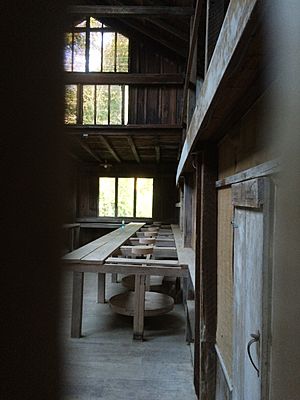Marguerite Wildenhain facts for kids
Quick facts for kids
Marguerite Wildenhain
|
|
|---|---|
 |
|
| Born |
Marguerite Friedlaender
October 11, 1896 |
| Died | February 24, 1985 (aged 88) Guerneville, California, U.S.
|
| Other names | Marguerite Friedländer, Marguerite Wildenhain-Friedlander |
| Education | Berlin University of the Arts, Bauhaus |
| Years active | 1914–1980 |
| Parents |
|
| Relatives | Henri Friedlaender (brother) |
Marguerite Wildenhain (born October 11, 1896 – died February 24, 1985) was an American artist who worked with clay. She was trained at a famous art school called Bauhaus. She was also a teacher and wrote books.
After moving to the United States in 1940, she taught at a place called Pond Farm. She also wrote three important books about pottery: Pottery: Form and Expression (1959), The Invisible Core: A Potter's Life and Thoughts (1973), and …that We Look and See: An Admirer Looks at the Indians (1979). Another artist, Robert Arneson, called her "the grande dame of potters," which means she was a very respected and important potter.
Contents
Early Life and Art School
Marguerite Wildenhain was born in Lyon, France, on October 11, 1896. Her mother was British, and her father was German. Her brother, Henri Friedlaender, became a well-known designer of typefaces (the letters you see in books).
Marguerite went to school in Germany and England. When World War I started, her family moved to Germany. In 1914, she began studying sculpture at the Berlin University of the Arts. Later, she worked at a factory decorating porcelain. This is where she discovered her love for the potter's wheel.
In 1919, she learned about the new Bauhaus school. It was founded by architect Walter Gropius. He wanted to bring together artists and craftspeople. Marguerite decided to join and became one of its first students. She studied at Bauhaus from 1919 to 1925.
Life at Bauhaus and Beyond
At Bauhaus, Marguerite Wildenhain learned from famous painters like Paul Klee and Wassily Kandinsky. She also worked closely with sculptor Gerhard Marcks and potter Max Krehan. In 1925, Marguerite made history. She became the first woman in Germany to earn the Master Potter certification. This was a very high achievement in pottery.
In 1926, she left Bauhaus. She moved to Halle-Saale, Germany, and became the head of the ceramics workshop at the Burg Giebichenstein University of Art and Design. She also designed beautiful dinnerware for a famous porcelain company. Some of her designs included the Halle tea set and the Burg-Giebichenstein dinner service.
In 1930, she married Frans Wildenhain, who was also a ceramic artist. He had been her classmate at Bauhaus and later her helper at Burg Giebichenstein.
Moving to America
In 1933, a political group called the Nazis came to power in Germany. Because of her family's background, Marguerite was forced to leave her teaching job. She and Frans moved to Putten, Netherlands. There, they opened a pottery shop called Het Kruikje (The Little Jug). They made and sold pottery to live.
As the Nazis began to invade other countries, Marguerite was able to leave Holland in 1940. She moved to New York in the United States. However, Frans could not get permission to leave at the same time.
Pond Farm Workshops

Marguerite moved from New York to California in May 1940. She taught at the California College of Arts and Crafts for two years. In the early 1940s, she moved to Pond Farm. This was a piece of land owned by architect Gordon Herr and his wife, Jane. Marguerite worked to create a pottery workshop there.
In 1945, Marguerite became a U.S. citizen. This allowed her to help her husband, Frans, move to the United States. He had been forced to join the German army during their separation.
The Pond Farm Workshops officially ran from 1949 to 1952. Gordon Herr, Marguerite, Frans, and other artists like textile artist Trude Guermonprez and metals artist Victor Ries ran the workshops. Other artists also taught there sometimes.
These workshops were very demanding. Students used a special "kick wheel" to create many ceramic items. They made flower pots, bowls, cups, and teapots. The focus was on mastering the pottery process, not just on finishing the pieces. During breaks, students and teachers talked about nature, music, and philosophy. Pond Farm was truly a "school for life." Many of Marguerite's students became successful potters. They said she helped them grow a lot as artists.
The workshops eventually ended for several reasons. Gordon Herr's leadership style, the artists' wish for shared ownership, and Jane Herr's death in 1952 all played a part. Frans also left Marguerite and took a teaching job in New York. Marguerite continued to live and teach at Pond Farm until 1979.
Later Years and Legacy
As Marguerite Wildenhain became more famous, she kept running her summer school. She accepted about twenty students each year. She also published her three books about pottery. She gave talks at schools across the U.S. and traveled alone to South and Central America, Europe, and the Middle East.
Marguerite Wildenhain passed away on February 24, 1985, at the age of 88, in Guerneville, California. After her death, the buildings and land at Pond Farm were saved. They are now part of the California State Parks system.
Recently, Pond Farm was named a "National Treasure" by the National Trust for Historic Preservation. Plans are now being made to fix up and protect her studio and home. Soon, Pond Farm will be open to the public in some way.
Writings
- Pottery, Form and Expression (New York, 1962)
- The Invisible Core: A Potter's Life and Thoughts (New York, 1973)
- …that We Look and See: An Admirer Looks at the Indians (Decorah, IA, 1979)
See also
 In Spanish: Marguerite Wildenhain para niños
In Spanish: Marguerite Wildenhain para niños
- Dean Schwarz


